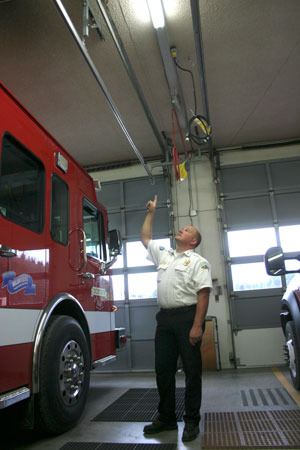A group opposing the South Whidbey Fire/EMS levy lift has its main argument in the name: Citizens Against Palatial Stations.
The informal group of a dozen South Whidbey voters assembled this week and will vote against a 15 cent levy increase.
Dean Enell, a vocal opposition leader in Langley, disagreed with the district’s basic premise of needing the money for operations.
“When I see what they’ve used that money for, I see that they’re over-funded,” Enell said.
South Whidbey’s fire protection and emergency services district has a budget of $2.24 million. The overwhelming majority of $2.01 million is budgeted for operations, with $205,000 planned for capital expenses such as facilities and engines.
Since 1990, the fire district’s capital expenses have spiked 11 years, coinciding with major purchases of fire engines, property and station construction. For the past 12 years, South Whidbey Fire/EMS has been a debt-free district, and since 1987, only twice accrued debt to pay off an aerial apparatus as part of annexing Langley and for the engine at the Clinton station.
“Do we want to make interest payments?” asked Fire Commissioner Kenon Simmons. “That’s the bottom line. Interest rates are coming down, but even at 3 or 4 percent, you’re paying double for that same building because of interest payments.”
“In years past, if the interest rate is up to 6 or 7 percent, you’re paying triple.”
The citizen opposition group has argued for the benefits of a stable budget. Using credit and loans to pay for facilities, which last 60 or 70 years, makes more sense to Enell and company.
“They cruise along, accrue a bunch of money then buy a building,” Enell said. “Had they done that (use credit), they would probably have a lot more cash in the bank right now and probably wouldn’t have to go out for a levy increase.”
Commissioners argued that building two stations and renovating two in the past decade was necessary. As the volunteer firefighter-based district’s buildings aged, they needed to be replaced. Recently, asbestos was discovered in two stations, which must be removed.
“I look at the big picture and long term,” Simmons said, citing the construction of the Langley station in 2008.
“The city of Langley, they were charging us rent and upping the rent. Also, it was nowhere near big enough for what we needed.”
When the Langley station was built on Camano Avenue, the fire district spent $2.45 million on capital expenses. Its operations expenses totaled $1.76 million. Enell argued that high revenue does not require high expense, especially for facilities.
“Just because they have the money, or were on the path to have the money, doesn’t mean they should do it,” Enell said.
“They portray that they need this for operational expenses. But the only operational expenses of any importance are the asbestos removal and some equipment they need to buy.”
Revenue for South Whidbey Fire/EMS has increased from $616,000 in 1990 to $2.25 million this year. The major bump in incoming funds has the Citizens Against Palatial Stations group worried because Whidbey General Hospital has a competing emergency medical service on the South End.
“What’s real disturbing about that is here’s a situation where we have dual EMS service,” Enell said.
“As it is right now, it’s a totally unsophisticated and uncoordinated dispatch system.”
Enell and the group have called for South Whidbey voters to reject the levy lift. Citizens Against Palatial Stations also proposed the fire district seek a modified levy request with a six-year sunset clause that would allow voters to consider if the district needs the money and had used it wisely.
“I’m perfectly happy with the service and the dedication from the fire district,” Enell said. “I would be the first one to continue to fund them at this service.”
The levy lift, if approved, would increase the tax rate to 76 cents per $1,000 of assessed property value. A property valued at $300,000 would pay $228 annually. The levy measure is on the November ballot.



